Midway through the last month of the year, it is a good time to look ahead to the new year. 2018 will undoubtedly feature its share of Catholic news, developments and, not least, opinions in social media. Every year since the launch of this blog has had had more than a few surprises, so a look at the future can’t be anything but incomplete, but there are a few things which we know will happen.
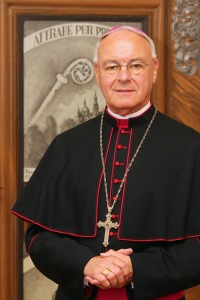 The retirement and appointment of bishops is pretty easy to predict, as bishops are legally bound to offer their resignation when they reach the age of 75. Locally, there are currently three dioceses without a bishop: Roermond in the Netherlands, and Hildesheim and Würzburg in Germany. In 2018, two more will likely join these: in Fulda, Bishop Heinz Josef Algermissen (at right) will celebrate his 75th on 15 February, and in Namur, Bishop Remy Vancottem will do likewise on 25 July. A third likely diocese to fall vacant in Ghent. Bishop Luc van Looy will turn 77 on 28 September. Upon his 75th birthday, the diocese made it known that Pope Francis had requested the bishop stay on for two more years, and that extension is up this year.
The retirement and appointment of bishops is pretty easy to predict, as bishops are legally bound to offer their resignation when they reach the age of 75. Locally, there are currently three dioceses without a bishop: Roermond in the Netherlands, and Hildesheim and Würzburg in Germany. In 2018, two more will likely join these: in Fulda, Bishop Heinz Josef Algermissen (at right) will celebrate his 75th on 15 February, and in Namur, Bishop Remy Vancottem will do likewise on 25 July. A third likely diocese to fall vacant in Ghent. Bishop Luc van Looy will turn 77 on 28 September. Upon his 75th birthday, the diocese made it known that Pope Francis had requested the bishop stay on for two more years, and that extension is up this year.
Other predictable events include the 80th birthdays of cardinals, the age at which they cease their duties in the Roman Curia and are no longer able to participate in a conclave. In 2018, six cardinals will mark this milestone:
- Antonio Maria Cardinal Vegliò on 3 February
- Paolo Cardinal Romeo on 20 February
- Francesco Cardinal Coccopalmerio on 6 March
- Manuel Cardinal Monteiro de Castro on 29 March
- Pierre Cardinal Nguyễn Văn Nhơn on 1 April
- Angelo Cardinal Amato on 8 June
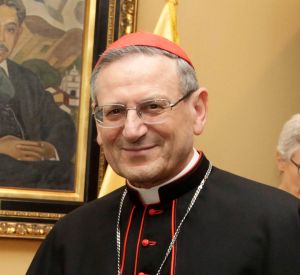 While all hold memberships in various dicasteries in the curia, two of these sit at the head of them: Cardinal Coccopalmerio is president of the Pontifical Council for Legislative Texts and Cardinal Amato (at left) is the prefect of the Congregation for the Causes of Saints. Cardinal Nguyễn Văn Nhơn remains active as archbishop of Hanoi. All will undoubtedly retire upon their 80th birthday, opening up some interesting positions in the curia. Barring any deaths, the number of cardinal electors will stand at 114 by mid-2018. Possibly not low enough for a new consistory by itself, but considering the fact that a further 10 ill age out in 2019, Pope Francis may decide to be proactive and call a consistory in autumn for the creation of anywhere between 6 and 16 new cardinals.
While all hold memberships in various dicasteries in the curia, two of these sit at the head of them: Cardinal Coccopalmerio is president of the Pontifical Council for Legislative Texts and Cardinal Amato (at left) is the prefect of the Congregation for the Causes of Saints. Cardinal Nguyễn Văn Nhơn remains active as archbishop of Hanoi. All will undoubtedly retire upon their 80th birthday, opening up some interesting positions in the curia. Barring any deaths, the number of cardinal electors will stand at 114 by mid-2018. Possibly not low enough for a new consistory by itself, but considering the fact that a further 10 ill age out in 2019, Pope Francis may decide to be proactive and call a consistory in autumn for the creation of anywhere between 6 and 16 new cardinals.
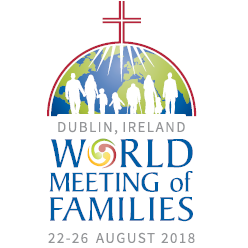 Speaking about the pope, he will, despite the fact that he has no love for travelling, visit several countries in 2018. In January, he will once again return to South America, visiting Peru and Chile. Ireland is on the schedule in August, when the Holy Father will attend the World Meeting of Families taking place in Dublin (logo at right). Visits not yet confirmed are to the Baltic countries in September and to Romania in December. A visit to India also remains an option, but as Pope Francis has just wrapped a visit to India’s neighbouring countries of Myanmar and Bangladesh, it may not be at the top of the list.
Speaking about the pope, he will, despite the fact that he has no love for travelling, visit several countries in 2018. In January, he will once again return to South America, visiting Peru and Chile. Ireland is on the schedule in August, when the Holy Father will attend the World Meeting of Families taking place in Dublin (logo at right). Visits not yet confirmed are to the Baltic countries in September and to Romania in December. A visit to India also remains an option, but as Pope Francis has just wrapped a visit to India’s neighbouring countries of Myanmar and Bangladesh, it may not be at the top of the list.
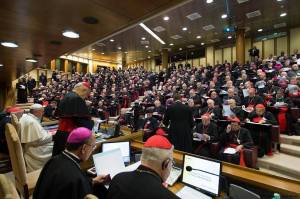 In the latter part of the year, all eyes will be on the Synod of Bishops again, this while the reverberations of the last two assemblies of that body are still being felt. The October 2018 Fifteenth Ordinary General Assembly of the Synod of Bishops while focus on “Young People, Faith and Vocational Discernment”. To this assembly, each bishops’ conference will elect one or more (depending on their size) delegates, while the Pope will also make a personal selection of delegates. One of these personal choices has already been made: Sérgio Cardinal Da Rocha, the archbishop of Brasília, was appointed as Relator General of next year’s assembly. He will outline the theme at the start of the assembly and summarise the delegates’ speeches so they can be condensed into concrete proposals.
In the latter part of the year, all eyes will be on the Synod of Bishops again, this while the reverberations of the last two assemblies of that body are still being felt. The October 2018 Fifteenth Ordinary General Assembly of the Synod of Bishops while focus on “Young People, Faith and Vocational Discernment”. To this assembly, each bishops’ conference will elect one or more (depending on their size) delegates, while the Pope will also make a personal selection of delegates. One of these personal choices has already been made: Sérgio Cardinal Da Rocha, the archbishop of Brasília, was appointed as Relator General of next year’s assembly. He will outline the theme at the start of the assembly and summarise the delegates’ speeches so they can be condensed into concrete proposals.
Photo credit: [1] Bistum Fulda, [2] Fotos Presidencia El Salvador/Wikipedia
 The Pontifical Council for the Laity is currently led by Cardinal Stanislaw Rylko, with Bishop Josef Clemens (pictured) as secretary. At 70 and 68 respectively, neither of these are about to retire, so if they do not remain in the dicastery, new appointments will have to be sought for them. Bishop Clemens is especially interesting, as the choice may be made to send him home to a diocese in Germany. At 68, he would be a transitional bishop, which would not go down well in the eastern German dioceses (of which Dresden-Meißen is vacant), where bishops have
The Pontifical Council for the Laity is currently led by Cardinal Stanislaw Rylko, with Bishop Josef Clemens (pictured) as secretary. At 70 and 68 respectively, neither of these are about to retire, so if they do not remain in the dicastery, new appointments will have to be sought for them. Bishop Clemens is especially interesting, as the choice may be made to send him home to a diocese in Germany. At 68, he would be a transitional bishop, which would not go down well in the eastern German dioceses (of which Dresden-Meißen is vacant), where bishops have 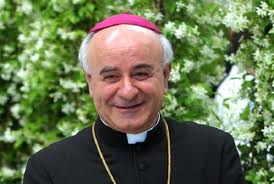 The Pontifical Council for the Family is led by Archbishop
The Pontifical Council for the Family is led by Archbishop  “The Church’s great focus on the family takes you places. Last year, in October, I was in Rome for two weeks for the Extraordinary Synod of Bishops on the family, in which I took part as president of the Dutch Bishops’ Conference. Two weeks ago I was in Philadelphia for the World Meeting of Familes. I gave an address there as part of one panel, and chaired another panel. At the moment I write this text, I am in Rome for the Ordinary Synod of Bishops. The Bishops’ Conference asked me to represent them here. This year, the Synod even takes three weeks.
“The Church’s great focus on the family takes you places. Last year, in October, I was in Rome for two weeks for the Extraordinary Synod of Bishops on the family, in which I took part as president of the Dutch Bishops’ Conference. Two weeks ago I was in Philadelphia for the World Meeting of Familes. I gave an address there as part of one panel, and chaired another panel. At the moment I write this text, I am in Rome for the Ordinary Synod of Bishops. The Bishops’ Conference asked me to represent them here. This year, the Synod even takes three weeks. Kerknet, the website of the Catholic Church in Flanders, features
Kerknet, the website of the Catholic Church in Flanders, features  The whole debate about nullification or dissolution of a marriage is an intricate one, and it should always be reminded that a marriage can not be nullified. It can only be established that it was null from the very beginning, to the effect that there never was a marriage to begin with. The reasons for this are many, but for the purpose of this blog posts it suffices to say that they establish the validity of the marriage. One of the most convincing for those outside the world of canon law and ecclesiastical courts is perhaps that a marriage must be entered into out of free will; there can be no coercion, for any reason. If someone was forced into a marriage, it can be established that the marriage was null, that it never existed.
The whole debate about nullification or dissolution of a marriage is an intricate one, and it should always be reminded that a marriage can not be nullified. It can only be established that it was null from the very beginning, to the effect that there never was a marriage to begin with. The reasons for this are many, but for the purpose of this blog posts it suffices to say that they establish the validity of the marriage. One of the most convincing for those outside the world of canon law and ecclesiastical courts is perhaps that a marriage must be entered into out of free will; there can be no coercion, for any reason. If someone was forced into a marriage, it can be established that the marriage was null, that it never existed. Bold headlines in the news yesterday. A brief selection from the ones I came across: “Pope wants to unite religions against gay marriage“, “Pope: Homosexuals destroy human nature“, “Pope: Gay marriage bad for future of family” and “Pope considers gay marriage threat to world peace“.
Bold headlines in the news yesterday. A brief selection from the ones I came across: “Pope wants to unite religions against gay marriage“, “Pope: Homosexuals destroy human nature“, “Pope: Gay marriage bad for future of family” and “Pope considers gay marriage threat to world peace“. Last Saturday, Pope Benedict XVI attended an evening of witness during his pastoral visit to Milan. There, several people had the opportunity to ask him a question. One of them was 7-year-old Cat Tien of Vietnam, who, greeting him with a simple “Ciao, Papa!”, asked the Holy Father about the memories of his childhood and family.
Last Saturday, Pope Benedict XVI attended an evening of witness during his pastoral visit to Milan. There, several people had the opportunity to ask him a question. One of them was 7-year-old Cat Tien of Vietnam, who, greeting him with a simple “Ciao, Papa!”, asked the Holy Father about the memories of his childhood and family. It may not be a big international journey (although, from Vatican City, almost any journey is an international one), the weekend trip that Pope Benedict XVI is taking to Milan is certainly one with an international flavour. Billed as a twofold pastoral visit, to the Archdiocese of Milan and the Seventh World Meeting of Families, it includes no less than thirteen events which the pope will speak at or attend.
It may not be a big international journey (although, from Vatican City, almost any journey is an international one), the weekend trip that Pope Benedict XVI is taking to Milan is certainly one with an international flavour. Billed as a twofold pastoral visit, to the Archdiocese of Milan and the Seventh World Meeting of Families, it includes no less than thirteen events which the pope will speak at or attend.